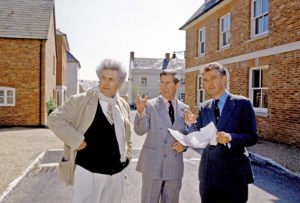At six o’clock in the morning of 16 May 1968, a 56-year-old cake decorator, Mrs Ivy Hodge, went to make a cup of tea in her 18th-floor tower block flat, Ronan Point, in East London. She filled the kettle, rested it on the hob and turned on the gas. The immediate and resulting explosion destroyed the four flats above her, ripped out the walls, and punched through every living room beneath her all the way to the ground floor, killing four of her neighbours.
Amazingly, Mrs Hodge survived — though any lingering public acceptance for “system-build” blocks, assembled from pre-fabricated concrete panels, hoisted into position and then bolted together, did not. Across the country, new tower and slab blocks became “hard to let”, to use the contemporary officialese, as potential tenants simply refused to move in. The Thamesmead Estate, completed in 1968, was only 40% full by 1974. Across London in Haringey, 55% of housing applicants wouldn’t move to the Broadwater Farm Estate within five years of its completion in 1971. Castle Vale, which opened in Birmingham in 1965, was so unpopular that by 1981 one-third of the apartments were empty.
Today, journalists are debating what the Department of Education did or didn’t know about the concrete RAAC crisis in school buildings. But the scandal cannot be blamed entirely on modern politicians: the seeds of this crisis were sown 60 years ago. Why was it acceptable then to build so shoddily? And what does it tell us about the philosophy of place-making and how we choose to live and build?
Let’s go back to the construction of these schools, and the corresponding homes and hospitals, in the Fifties, Sixties and Seventies. It was a brave new world. British cities had been bombed by the Luftwaffe and tarred by 200 years of coal-consuming fireplaces. The NHS was young. Anything and everything Victorian was besmirched with the heavy legacy of war and ornament. All over the country, tall, well-aerated Victorian schools and hospitals were abandoned for more modern constructions with cleaner lines, flatter roofs, more car parking and a simpler, machine-age aesthetic.
What could be more natural than to build modernity out of modern materials and methods? Why sully the future with bricks that need hand laying or wood that needs crafting or joining when new, lightweight, low-cost concrete can be poured and shaped in (at least nominally) automated factories? And why build sloped roofs to let the rain run off, as humans had done for 1,000 years, when modern materials could defeat the weather?
This mania for modernity infected every aspect of housing policy. Sheffield’s iconic Park Hill housing estate was modelled, according to Roy Hattersley, the chairman of the housing committee, on the Unité d’Habitation in sunny Marseilles, designed by the Swiss high priest of architectural modernism, Le Corbusier, who had famously proclaimed that houses were “machines for living”. Surely schools and hospitals could likewise be machines for learning or curing, undistracted by corbels or columns, pilasters or pedestals?
This was certainly cheaper: no fiddly bits to fix, no craftsman to employ. The seven firms that dominated the construction market pushed this agenda mercilessly and oiled it with parties for public officials. Some even offered backhanders and bribes. Architects and public officials convinced themselves that it was also morally better, responding to the “spirit of the age” and to the unprecedented needs of “modern man”.
But, and here is the rub, it was all total nonsense. Baloney. Unevidenced. Spurious. Faux science. A triumph of assertion over observation, of faith over facts, of hope over reality. In ripping up all organic experience, in defying the weather, in experimenting recklessly with new materials for fundamental parts of buildings, the “modern men” of the Fifties and Sixties made two fundamental errors.
First of all, they forgot that humans are not machines: they are emotional beings with hopes and fears, with needs for community and for belonging, for beauty and for purpose. Despite 70 years of trying, people have still not been able to attach themselves to a modernist building aesthetic that treats them as cogs in the machine not souls to be nurtured. As the cartoonist Osbert Lancaster put it 60 years ago, the modernist vision “presupposes a barrenness of spirit to which, despite every indication of its ultimate achievement, we have not yet quite attained”. We still haven’t. In every single visual preference survey conducted across multiple countries, between 70% and 90% of people prefer streets and buildings which are more organic, more sinuous, more textured, and that don’t necessarily conform to the machine-age aesthetic created two generations ago.
This is more than a question of taste: it is about the way people live. In fact, much of the data on health and wellbeing suggests that architecture affects how well people feel. Consistent evidence now shows that we get better faster and more reliably in more beautiful, natural hospitals than in the ghastly, climate-controlled white boxes we have created over the last 70 years.
Post-war architects were shockingly dismissive of public preferences. Le Corbusier had exhorted his acolytes to take courage from Louis XIV or Napoleon: “Golden moments when the power of the mind dominated the rabble.” The British architect Maxwell Fry agreed. He warned that architects should address “ourselves only to those capable of understanding us, and let the rest go hang”.
The post-war building boom had a second problem: innovating with building design is different to innovating with how you design your cars or phones or coffee machines. Buildings are meant to stick around. The great advantage of tried-and-tested materials and forms is that, if they are still with us, we know they last. No innovator or engineer, no matter how brilliant, no matter how well-intentioned and thoughtful, can truly be certain that their wonder material or form will survive in the real world, as the tragedy of Ronan Point and the current concrete scandal both show.
One of the first post-war schools, Hunstanton Secondary Modern School, offers another example. After opening in 1954, it suffered from many years of poor performance. The critic Martin Pawley wrote in 1984: “It is in a class of its own for glazing failure, heat loss, acoustic reverberation and maintenance.” Sadly, he was wrong. Many other post-war buildings have been just as bad.
That’s not to say that we should not innovate in the buildings we create. Of course, we should — all the time. Ceaselessly, energetically and ambitiously. But in doing so we should be respectful of the weather, of common sense, and of observed reality. And we should be humble about how we use new materials when we are not certain of their staying power.
New buildings should get better, not worse, with the centuries; as we get richer, new buildings’ utility, beauty, and longevity should improve not degrade. Sadly, we still get this wrong too often — and in some “traditional” designs as well as modernist ones: thin veneer bricks so brittle that rubberised mastic fault lines with a lifespan of 20 years are necessary to absorb the movement; short-lived plastic trays to collect the rain, which then seeps out through unseemly weep-holes.
No parent should say, as I do today, “thank heavens my children use school buildings constructed in the 19th century not the late 20th century”. That we are tearing down shoddy buildings created in living memory only goes to show the fickle nature of architectural progress.
Disclaimer
Some of the posts we share are controversial and we do not necessarily agree with them in the whole extend. Sometimes we agree with the content or part of it but we do not agree with the narration or language. Nevertheless we find them somehow interesting, valuable and/or informative or we share them, because we strongly believe in freedom of speech, free press and journalism. We strongly encourage you to have a critical approach to all the content, do your own research and analysis to build your own opinion.
We would be glad to have your feedback.
Source: UnHerd Read the original article here: https://unherd.com/




